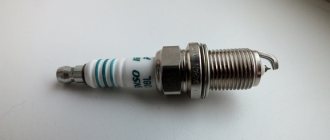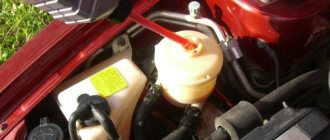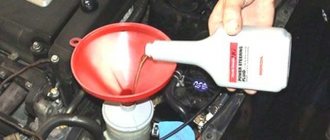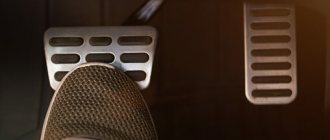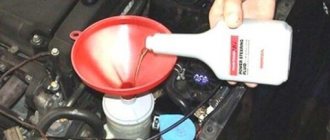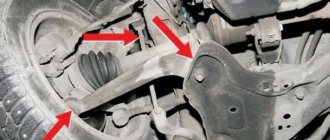It is necessary to dispel the most important myth - the car can be operated even without sufficient fluid in the power steering. The steering wheel will squeak a little, but this load is acceptable. Oil can be added another time.
This is the most common mistake and will lead to the following consequences:
- Lack of pressure in the power steering system due to insufficient oil will damage the power steering pump;
- A malfunctioning system - the steering wheel will take all the impacts and unevenness of the road, increased load on the steering rack, which will ultimately result in new repairs and replacement.
Power steering
In a separate line, let’s say a few words about power steering. There are two types of these devices used in machines:
- hydraulic
- electric
Power steering
The power steering (hereinafter referred to as GI) is based on the transmission of power from the engine to the rack through a hydraulic device. It is a pump that creates pressure in the GI system. Operates when the engine is on.
Rice. 3. Power steering
Valves on the shaft allow oil to flow into the oil lines. Where the oil goes depends on the direction the steering wheel is turned. This scheme ensures that the wheels turn in the desired direction without unnecessary effort. Malfunctions of the steering wheel with power steering can be in:
- pump
- distributor valves
- piston cylinder system
- cylinder seals
- drive belt
IMPORTANT: such complex faults can only be identified and repaired by professionals. ADVICE FROM AN EXPERIENCED CAR OWNER: use high-quality motor oils recommended by the manufacturer of your car
Don't skimp on your safety and the safety of your loved ones
ADVICE FROM AN EXPERIENCED CAR OWNER: use high-quality motor oils recommended by the manufacturer of your car. Do not skimp on your safety and the safety of your loved ones.
Electric power steering
An electric motor causes the gear to rotate. She moves the gear shaft. Rotation direction sensors send a corresponding signal to the control unit. The engine, in accordance with the received signal, moves the rack in the desired direction. An electric booster (hereinafter referred to as EA) is a fairly reliable device in a car, but breakdowns can occur in it too. For example, they can:
- programs crash
- rotary sensor fails
Rice. 4. Electric power steering
Unlike a power steering unit, an electric amplifier can operate without turning on the engine. The mechanism structure is shown in Figure 4.
Repair of the steering wheel control unit is best carried out at a reputable service station; do not contact private sellers, so as not to permanently damage the part.
IMPORTANT: damage can only be diagnosed using special equipment. Trust this work to professionals
For example, to find out whether a backlash is a deviation from the norm, you need to know the standard embedded in the part. Usually this figure is equal to 9-10 degrees. To measure it, you need a special device - a backlash meter. If you don’t have one, contact a service station.
Checking the damper
In fact, every motorist can handle the recirculation damper on the Opel Astra H and other models independently. The first priority will be to confirm that the element is faulty.
To confirm or deny a breakdown of the interior air recirculation damper, the car owner can use one of two methods, or combine both diagnostic methods at once. To do this, it is not necessary to go to a service center if you plan to do the replacement or repair yourself.
The first method involves determining if there is a problem by hearing. There is no need to disassemble or dismantle anything here. The procedure looks like this:
- the ignition is turned on;
- the engine does not start;
- any possible sources of noise in the cabin are turned off (audio system, airflow, etc.);
- the driver also shuts up and listens carefully;
- the recirculation activation button is pressed;
- The duration of the buzzing sound in the glove compartment area is determined.
The sound will definitely be heard even if the damper is working properly. It all depends on the duration of the electric drive sound. If the sound is observed for 2-3 seconds, this indicates that there are no problems. That is, the damper is working normally.
But when the sound is longer, lasting about 10 seconds, accompanied by clicks and uneven sound vibrations, the damper has failed. The unit requires repair or replacement. This will become clear during dismantling.
If you want to diagnose the recirculation flap in your Opel Astra as accurately as possible, then you will have to resort to the second method. This is already a visual check of the element’s condition.
This diagnosis is performed step by step:
- the glove compartment is dismantled;
- the ignition is turned on;
- the engine starts;
- the interior air blower turns on at maximum speed;
- the recirculation button is pressed.
If the damper starts to move within 2-3 seconds and freezes at its end point, everything is fine with it and no malfunctions are observed.
When the movement becomes uneven, clicks or pops appear in parallel, the position of the damper changes several times and the sound from the escaping air changes, and all this takes about 10 seconds, then the element has failed.
Air recirculation damper micro-reducer
Causes of malfunction
Do-it-yourself replacement of fluid in the power steering
The gear and gear base are the ones that experience the most stress in the steering rack. Most breakdowns happen to this part of the unit. Among the most common types of breakdowns are:
- tie rod end wear
- tooth wear
- mechanical destruction of teeth
Usually the last two problems are eliminated by adjusting the nut that controls the stop. If the teeth themselves break, you need to replace either the rack or gear. If parts wear out, the technician simply replaces them.
IMPORTANT: if a problem arises and the mechanism needs to be adjusted, contact a specialist so that your car’s steering can be your reliable assistant. The reliability of the entire unit depends on the correctness of the manipulations during adjustment.
The backlash is formed due to poor-quality road surfaces, which we all have to put up with. Driving through obstacles in the form of speed bumps, concrete joints and other irregularities has a detrimental effect on the function of the Opel Astra h steering rack. Also not the least factor is driving style.
ADVICE FROM AN EXPERIENCED CAR OWNER: before potholes and pits, you need to brake the car well. This will not save you from the appearance of backlash, but it will extend the life of the car and delay the breakdown of the part.
After 10-15 years of operation, almost every car experiences difficulties with steering. Foreign manufacturers give an unequivocal recommendation to their customers: replace the device.
But it is not always possible to find the necessary “original” part. Therefore, to eliminate play on the steering wheel, they often use a “tightening” of the mechanism. But when performing it, you need to remember that the life of the gearbox is not endless.
Drive unit
How to change the drive belt on a grant fret yourself?
Drive shaft, CV joint (grenade), Outer CV joint, Inner CV joint, Right CV joint, Left CV joint, CV boot, Tripoid, CV joint nut, Retaining ring, Cardan, Crosspiece, Suspension bearing, Cardan bearing, Elastic coupling, Axle, Front axle, Rear axle, Axle reducer, Gearbox bearing, Gearbox oil seal, Differential, All-wheel drive sensor, Haldex coupling, Differential bearing, Differential oil seal, Planetary gears, Axle bearing, Axle shaft, Axle shaft bearing, Axle oil seal, Axle shank, Shank bearing, Axle bearing, Transfer case, Transfer case, Transfer case oil seal, Transfer case bearing, Transfer case chain
Partial replacement for Opel Astra h and other cars
What kind of liquid to pour into the power steering: we sort out all the myths
Many motorists carry out only partial fluid changes. That is, if a drop in level is detected, new oil is simply added to the old one (if the liquid leaves too quickly, it is advisable to check the system for leaks).
When topping up, the most important point is the correct selection of new oil.
- Google+
- LJ
- Blogger
The main indicator that car owners should focus on is the base color of the liquid. That is, oil of the same color that is already used is poured into the tank (during operation, the product darkens significantly, so you need to look at the initial indicator).
As a last resort, if the desired color is not available, you can mix yellow and red liquid. However, combining yellow and green is not recommended. If you have a choice between adding a fluid of a different color or transmission oil, then it is better to go with the second option.
Is it possible to fill the power steering with engine oil?
Motor - definitely not, transmission - with reservations. Next we will look in detail why.
To understand whether other oils, such as motor or transmission oils, can be poured into the power steering, you need to know what functions it performs.
The power steering fluid must cope with the following tasks:
- Lubrication of all power steering components;
- Protection against corrosion and wear of parts;
- Pressure transfer;
- Prevents foaming;
- System cooling.
The above characteristics are achieved by adding various additives, the presence and combination of which gives power steering oil the necessary qualities.
As you understand, the tasks of motor oil are somewhat different, so it is highly not recommended to pour it into the power steering.
Regarding transmission oil, everything is not so clear; the Japanese often use the same ATF fluid for automatic transmission and power steering. Europeans insist on using special PSF (Power Steering Fluid) oils.
Differences in changing power steering fluid in different Opel models
Replacing power steering fluid on an Opel Antara with a z32se engine can only be done with synthetic oil. The reason is that in a diesel engine, the method of distributing lubricant in the system is replete with a large number of rubber seals; mineral oil does not have a very favorable effect on their technical operating properties.
Changing power steering oil in an Opel Antara, in theory, has no service life limitations, but it is better to perform this operation based not on mileage, but on the color of the mixture - dark or brown oil requires immediate replacement.
Replacing the fluid in the power steering on an Opel Astra can be done with synthetic and semi-synthetic oils. The use of mineral-based oil is possible, but only if the replacement is carried out after 50-60 thousand km.
Opel Astra, Opel Vectra, Opel Zafira - have a gasoline engine, any type of power steering oil is suitable
The reservoir is located the same way - at the right wheel shock absorber strut. Also pay attention to the following: later models have rubber parts treated with silicone in the hydraulic booster, but during operation they lost their protective properties (this applies to the Vectra and Omega models). It is better not to use liquids based on mineral additives
Only semi-synthetic - extend the operation of the system for even longer.
Different types of oils
Dexron
- a separate class of ATF fluids from General Motors, produced since 1968. Dexron is a trademark, produced both by GM itself and by other companies under license.
ATF
(Automatic Transmission Fluid) - oils for automatic transmissions, often used by Japanese automakers and in power steering.
P.S.F.
(Power Steering Fluid) - literally translated as power steering fluid.
Multi HF
– special, universal power steering fluids that have approvals from most automobile manufacturers. For example, CHF liquid, produced by the German company Pentosin, has received approvals from BMW, Ford, Chrysler, GM, Porsche, Saab and Volvo, Dodge, Chrysler.
Brakes
Brake pads, Drum pads, Pad wear sensor, Pad repair kit, Pad spacer, Rear pads, Handbrake pads, Front pads, Brake linings, Brake discs, Rear brake discs, Front brake discs, Brake drum, Rear brake drum, Drum bearing, Brake hoses, Brake pipes, Brake caliper, Caliper repair kit, Rear caliper, Caliper guides, Front caliper, Caliper piston, Caliper boot, Caliper bracket, Hydraulic accumulator, Vacuum brake booster, ABS, ABS unit, ABS sensor, Vacuum pump, Brake pedal, Switch Brake Light, Air Brakes, Parking Brake, Handbrake Cable, Brake Cylinder, Master Cylinder, Brake Reservoir, Brake Service Cylinder, Rear Brake Cylinder, Front Brake Cylinder, Brake Cylinder Repair Kit
Opel Astra H: replacing power steering fluid in car services
If the criterion for changing engine oil is the mileage of the car, then the quality of the amplifier fluid does not depend on the number of kilometers traveled by the car. The frequency of changing the Opel Astra H power steering oil is determined solely by time. It is believed - automakers and car service specialists agree with this statement - that this should be done at least once a year. For example, during spring maintenance when preparing the car for the summer season.
Important! Power steering oil must also be replaced if it leaks. In this case, after eliminating the cause of the leakage, it is better to pour the product completely rather than simply top up to the required level
It will also be necessary to replace the fluid if you notice that it has changed color - this indicates that its resource has been exhausted.
There are three main types of fluids for filling the power steering reservoir. They all differ in color:
- Red. It is the most expensive and is used mainly in power steering of cars with automatic transmission and can be either mineral or synthetic. Theoretically, it can be mixed with a yellow liquid (although it is better to do this only in case of emergency), but under no circumstances with green.
- Green fluid is used only for cars with a manual transmission. This synthetic oil with a fairly large number of additives is not recommended to be mixed with any others.
- Universal power steering fluid is yellow. It can be used in hydraulic boosters of almost any car, regardless of the design of their gearbox.
When choosing power steering oil for the Opel Astra N, you don’t even have to look at its manufacturer or study its technical characteristics in detail - you just need to decide which color fluid is best suited for your car. Considering that most of these cars are equipped with an automatic transmission, this will be either a red or yellow product. Its quality can only be guaranteed by the integrity of the seller - a specialized auto parts store or service station.
Important! Before pouring new oil into the power steering reservoir, you need to allow the old one to drain as completely as possible. Better yet, use special products to flush the entire working circuit of the system.
Indeed, such a procedure can only be carried out efficiently in a car service center.
Checking the Opel Astra power steering fluid level
Place the car's wheels in a straight ahead position. If the working fluid in the hydraulic system has cooled down, there is no need to start the engine. You can also check cold oil.
| Rice. 5.13 . Checking the fluid level in the hydraulic system reservoir: 1 – reservoir cap; 2 – measuring probe |
The steering hydraulic system reservoir is located at the rear of the engine compartment. Check the level using the indicator on the cover. Unscrew the cap, wipe the indicator rod with a clean cloth and screw it tightly into place. Unscrew the cap again: the level should be 2 mm below or above the “MIN” mark (Fig. 5.13).
If the fluid operating temperature is 50 °C, measure the level in the same way. The level should be between the “MIN” and “MAX” marks.
If the level is higher than normal, then it is necessary to withdraw the fluid. If it is below normal, check the system for leaks or add working fluid.
Video about “Checking the power steering fluid level” for Opel Astra
Opel Astra J 2012 checking the oil level in the automatic transmission.
How to check the oil level in an automatic transmission. Video instruction.
add power steering fluid to the reservoir opel astra h
Body
Bumper, Front Bumper, Washer Cap, Rear Bumper, Bumper Grille, Bumper Absorber, Bumper Molding, Rear Bumper Molding, Front Bumper Molding, Bumper Skirt, Rear Bumper Skirt, Front Bumper Skirt, Bumper Reinforcement, Bumper Bracket, Bumper Cover, Rear Cover Bumper, Front bumper cover, Bumper cover, Bumper mount, License plate frame, Fender, Front fender, Rear fender, Fuel filler flap, Fender liner, Front fender liner, Rear fender liner, Fender cover, Fender molding, Fender mount, Fender arch, Hood, Hinge Hood, Hood Cable, Hood Insulation, Hood Seal, Hood Hook, Hood Support, Hood Damper, Trunk, Trunk Damper, Trunk Door, Trunk Button, Trunk Latch, Trunk Lid, Trunk Trim, Trunk Shelf, Trunk Seal, Trunk Support, Doors , Front door, Rear door, Door trim, Door molding, Door handle, Window lifter, Door hinge, Door seal, Door limit switch, Mirror, Side mirror, Left mirror, Right mirror, Mirror element (glass), Mirror button (adjuster), Mirror cover, Mirror cover, Mirror turn signal, Glasses, Windshield, Rear glass, Rear window defogger button, Door glass, Glass seal, Glass molding, Frame, Windshield wiper, Washer reservoir, Washer motor, Wiper motor, Washer nozzles, Trapezium, Motor Windshield wiper, Wiper rod (drive), Wiper blades, Wiper rubber, Lock, Door lock, Lock set, Central locking, Central locking button, Ignition switch, Ignition key, Trunk lock, Fuel tank lock, Hood lock, Lock cylinder, Trim, Grille radiator, Emblem, Air intake (jabot), Mud flaps, Roof molding, Door sill, Arch extension, Panels, Radiator panel, Headlight frame, Threshold, Rear panel, Underbody, Trunk floor, Roof panel, Radiator protection, Side members, Nameplate, Sidewall, Battery mount, Noise insulation, Fasteners, Clips, Pistons, Hatch, Hatch button, Elastic elements
Opel Astra Opel Astra N (isitronic › Logbook › Replacing power steering fluid Opel Astra N
In 8.5 years, 74,000 km were covered. I decided to change the power steering fluid. My steering rack is TRW. I identified it by the tank (the shape of the power steering tank is low and round - this is TRW, if it is narrow, tall, white, similar to a liter of oil - this is ZF).
Full size TRW steering rack
To do this, I ordered power steering fluid FEBI 06161 - 1 liter for 582 rubles. In the product description in Autodok, the following information is available: febi 06161 (synthetic) central hydraulic fluid is designed for use in central hydraulic systems, ride height control, hydropneumatic suspension, as well as shock absorption and steering in the range from –40 °C to +130 ° C. Painted green.
For the convenience of pumping out the old liquid, I purchased a Janet syringe at the pharmacy. Not every pharmacy has one. I had to travel halfway across the city to buy such a syringe. It was in a single copy. I bought it for 105 rubles.
I poured the new FEBI liquid into a transparent glass.
And so we get to work. To begin with, I stopped the rear wheels.
And I hung the front ones with stumps.
Having unscrewed the cap I saw that the liquid level was less than necessary. There is a dipstick on the lid, so it was dry.
Using a syringe, Janet pumped out the old fluid from the tank.
It looked clean, but compared to the new liquid, it was dark.
I poured new liquid into the tank using the same Janet syringe. Carefully turned the steering wheel from edge to edge 10 times. The second time the liquid was almost as dark as the first time. Left 1st time, right 2nd time.
I fill in new fluid again. Carefully, slowly, without jerking, I turned the steering wheel from edge to edge 5 more times. Then he asked his wife to turn the steering wheel, and he began to observe what was happening there. It was clear that the liquid was leaving and at the same time air bubbles were coming out. Air enters the system, but gradually comes out when the steering wheel is rotated. The main thing is to turn the steering wheel smoothly, without sudden movements and without turning on the engine! The third time the liquid was slightly lighter than the second time. On the left 1st time, in the middle - 2nd time, on the right - 3rd time.
The fluid in the power steering reservoir has become lighter than it was originally. Bring the fluid level to the desired level. According to the placebo effect, the sound of the power steering decreased. Well, I didn’t notice any special changes in the work of the power steering. In any case, the fluid in the system has been renewed. In a couple of years I will perform this operation again. Soon I will change the front and rear brake linings, and at the same time I will change the brake fluid in the brake system and electronics. Spring is just around the corner. Good luck to everyone on the road.
PS A week later I checked - the power steering level is normal.
What power steering level should be in the reservoir??
Hi all. I periodically look into the fluids, today I discovered that my reservoir of power steering fluid is full, it doesn’t reach the neck by about 1 cm. Plus, it is the color of butter, brown, almost black. Last year (or the year before) I topped it up because... the dipstick was wet at the very tip. I added just a little. There is no level on the dipstick, I can’t determine what the norm is for this unit. I think I’ll even bother replacing the fluid, but I’m a little scared that it could end badly for the pump... And how can the fluid turn black? Workout? I don't understand... it's quite runny. I pull out the dipstick and a drop falls from it.
Astra H 5D, Z18XER 140 hp, cosmo. Dream car!
- 19.05.2014 21:24
Local Bachelor of ASTRAnomy
Message from Salionov
There is no level on the dipstick, I can’t tell
There is a level mark there, look carefully.
OPEL ASTRA H – Z16XER
“handle”, cosmo. - 19.05.2014 21:26
Local Honored Flooder
https://opelastrah.ru/proverka-urovny...ravleniya.html
There was an Astra G hatch x16xel, now there is an Astra H hatch z16xer. Both manual transmissions. And also Chevrolet NIVA LE for bad roads
- 19.05.2014 21:28
Message from VVVolf
I have a white lid with a probe, the probe is about 4-6 cm long, on the base of the probe there is some white garbage that is removed from this probe. There is no level on the dipstick itself, I’ve been trying to find it there for years now))
Astra H 5D, Z18XER 140 hp, cosmo. Dream car!
- 19.05.2014 21:42
Local Honored Flooder
Look at the marks on your tank. In ZF it seems like this
There was an Astra G hatch x16xel, now there is an Astra H hatch z16xer. Both manual transmissions. And also Chevrolet NIVA LE for bad roads
- 19.05.2014 21:49
Yes, I’ve been googling all evening, my tank is ZF, the level is somewhere very deep behind the engine... What about the color? Is it worth taking a steam bath? Mileage 110 thousand. Should I change the fluid? There are no problems with the operation of the power steering, tomorrow I will pump out the excess as I go, apparently I added too much... I thought I should measure it using the dipstick. And what are the dangers of overflowing liquid?
Astra H 5D, Z18XER 140 hp, cosmo. Dream car!
- 20.05.2014 00:41
Local Honored Flooder
Change the fluid and bleed https://opelastrah.ru/prokachka-siste...ravleniya.html Oil seals do not like overflowing fluid.
There was an Astra G hatch x16xel, now there is an Astra H hatch z16xer. Both manual transmissions. And also Chevrolet NIVA LE for bad roads
- 20.05.2014 08:35
Message from VVVolf
Change the fluid
don't you need to hang up the front end? Can I just do it in the parking lot?
Astra H 5D, Z18XER 140 hp, cosmo. Dream car!
- 20.05.2014 09:53
Local Honored Flooder
Don’t bother with the level, the seals don’t care about the level if the pump there gives a pressure of 40 bar. and replacement before 100tkm does not make sense IMHO
- 20.05.2014 10:05
Message from Victor Vasilievich
and replacement before 100tkm does not make sense IMHO
I have 110 thousand mileage
Astra H 5D, Z18XER 140 hp, cosmo. Dream car!
- 20.05.2014 10:17
Local Experienced Astravod
the pump there gives a pressure of 111 bar - 100 atm) so for reference, on the pump itself there is a marking with pressure .. I don’t care how much the level is, as long as it is not lower than the plastic casing inside the bottle, if it is visible then top it up, but in general I would be interested in where the liquid is leaving...
- 20.05.2014 14:21
Message from Warms
where does the slurry go?
Yes, the Christmas trees are matalka. I’m telling you, it doesn’t go away, I overfilled it out of ignorance once! I thought the dipstick should show the level, but on these models it’s not like that.
Astra H 5D, Z18XER 140 hp, cosmo. Dream car!
- 20.05.2014 22:15
Local Honored Flooder
Message from Warms
the pump there gives a pressure of 111 bar - 100 atm) so for reference, there is a pressure marking on the pump itself..
Can you imagine what kind of pressure this is and why it is needed and when the pump reaches this mode?
- 03.04.2015 20:17
Forum members, please tell me, is this a ZF tank? Does it have a dipstick if you unscrew the cap? There are some leaks on the steering rack, but the steering seems to be normal...
«Previous topic|Next topic»
Topic information
Users viewing this topic
This topic is viewed by: 1 (users: 0, guests: 1)
Forum administrator: Admin.
Recommendations for servicing the brake system on the Opel Astra h
The main rule for servicing brakes on a car is to diagnose the brake fluid level. Before each long trip or after a couple of weeks of inactivity, you need to look into the expansion tank and determine the level of brake fluid. If the volume is insufficient, it is necessary to top up the product.
The brake fluid itself must be stored in the shade, at room temperature, in a completely sealed container. The cap on the canister with the product must be tightly screwed on - otherwise moisture molecules will penetrate into the brake fluid, which will significantly reduce its shelf life and performance. That is why it is strictly forbidden to pour liquid into another container - the “brake fluid” should only be stored in its original packaging.
Why do you need to change the power steering fluid?
Many people mistakenly believe that power steering fluid does not require replacement for the entire service life of the car. But in fact, automakers say that it is only valid for the entire warranty period. That is, if you plan to use the car for no more than 3-5 years, changing the power steering oil is really not necessary.
WATCH THE VIDEO
Under harsh operating conditions (heating, temperature changes), the oil loses its properties over time: it changes color and structure. Driving a car is becoming increasingly difficult. Extraneous noise may appear, and, in extreme cases, a burning smell may appear.
If these signs appear, you need to change the oil in the power steering as soon as possible. If this is not done on time, expensive repairs may soon be needed.
Color classification
It is wrong to be guided only by color gradation when choosing oil, although this practice is widespread among car owners. It is also often indicated what color liquids can be mixed and which ones should not be mixed.
Mixing is contraindicated with liquids based on composition and not color, and since now both mineral water and synthetics can be presented in any color, you should treat this information very carefully.
Red ATF gear oil is usually synthetic, the Dexron brand from General Motors is considered the standard, but there are products from other manufacturers, such as Revenol, Motul, Shell, Zic, etc.
Yellow oil, produced by the Daimler concern and under its license, is used in Mercedes-Benz hydraulic boosters. It can be synthetic and mineral.
Green oil. For the most part, multifunctional and universal liquids can be either synthetic or mineral in composition. They are used in power steering, suspension and other systems that operate on liquids. It cannot be mixed with other colors, except in cases where the manufacturer declares full compatibility, for example Comma PSF MVCHF is compatible with some types of Dexron.
We will carry out the replacement professionally
How to visually determine a breakdown? Follow these simple recommendations: • Moisture and air enter the power steering system. As a result, noise and unstable operation of the steering wheel are heard from under the steering column; • When turning or turning the car, much more effort must be applied; • When parked, leaks are visible from under the steering column. The power steering system may be broken; • Carefully inspect the engine compartment - fresh stains in the places where the pipelines are attached indicate a leak in the system and its possible imminent clogging. Air entering the power steering pump distribution valve is especially dangerous. It's very easy to keep your driving safe. It is necessary to send the car for routine diagnostics and replace consumable parts. This is easy to do - contact the Tech service in Moscow, 50 km away. MKAD, in Zarechye.
Opel Astra N: replacing power steering fluid taking into account its properties
Important! During circulation through the working circuit of the system, power steering oil does not come into contact with any other liquids or contaminated parts, or with air. Therefore, in an ideal system, its properties should not change even with intensive and long-term use of the car.
But, unfortunately, the existence of ideal systems is only possible in theory. In practice, this liquid can leak through cracked seals or worn hoses, coming into contact with air and becoming contaminated. Accordingly, its properties deteriorate.
Power steering oil can be mineral or synthetic. But it is believed that it is better to use a mineral-based liquid. The fact is that power steering contains many rubber and plastic components, and synthetic oils, many of which contain rubber fibers, can corrode even particularly strong and wear-resistant compounds over time. Mineral, on the contrary, protects the metal components of this mechanism from corrosion and does not destroy rubber seals and plastic hoses.
Power steering oil must have the following properties:
- a certain viscosity, which would allow it to move freely along the working circuit and at the same time protect its metal components from corrosion (the viscosity of power steering oil is much lower than that of engine oil;
- resistance to compression - otherwise the amplifier would not be able to effectively perform its job);
- resistance to temperature changes, so that the properties of this product remain unchanged not only regardless of the time of year, but also on the engine temperature.
Unfortunately, over time there may be a time when it will need to be replaced, even if the fluid circuit is intact and there have been no leaks. This happens because the properties of the product deteriorate - first of all, this concerns its viscosity.
Types and functions of power steering fluid
The hydraulic booster allows you to turn the steering wheel without much effort thanks to the PSF working fluid, which transmits force from the pump to the piston. The quality of the power steering depends precisely on the quality of the PSF and the level of this composition in the system.
The liquid is an oil that performs the following functions:
- protection of system components and elements from corrosion;
- heat removal during friction of parts against each other, preventing overheating of the rubbing parts.
The functionality of the oil depends not least on the additives it contains. In particular, additives affect the foaming properties of the composition.
Often, the quality of a liquid is determined by many car owners only by its color. However, the color of the oil does not completely determine all its properties.
Instead, it is worth considering the main characteristics of the liquid, by which you can judge the quality:
- viscosity;
- foamability;
- hydraulic qualities;
- mechanical qualities;
- Chemical properties.
Power steering oil can be mineral or synthetic. Mineral compounds are usually used due to the presence of rubber elements in the power steering system. Rubber products dry out over time under the influence of significant loads on the steering mechanism, and mineral-based oil has a beneficial effect on rubber parts, extending their service life.
Synthetic power steering fluid is used much less frequently.
We recommend
“How to change wipers on a car: we understand the design and manufacturers” Read more
Power steering oil can be of different colors: red, green or yellow. In this case, you can only mix the red composition with the yellow one. Green oil is not intended to be mixed with others. It is also advisable not to mix synthetic and mineral products with each other.
Synthetic or mineral-based red PSF is typically used only in automatic transmissions. In hydraulic boosters, this fluid is used much less frequently. It is allowed to mix red compounds with yellow ones, provided their characteristics are mutually compatible.
There is a significant selection of power steering oils on the market, produced by a large number of manufacturers. This causes certain difficulties for car owners when choosing the appropriate composition.
Requirements for power steering fluid:
- The composition must be safe for passengers and the driver, since during operation it heats up and partially turns into steam.
- The fluid must operate at high temperatures (over 100 degrees Celsius). Low-quality oil under such conditions can curdle and foam, as a result of which the system’s performance deteriorates until it fails. If the power steering is faulty, the steering wheel will turn, but with much greater force.
- The product should not produce foam.
In addition, the oil must meet the requirements established by the vehicle operating instructions.
This is interesting: Malfunctions of the fuel injection system of the Opel Astra H
Video “Connecting the tester to the Opel Astra”
You can learn more about connecting the diagnostic tester to an Opel Astra car from the video.
It’s a rare car today that doesn’t have a power steering mechanism. This is either an electric power steering (EUR) or a hydraulic power steering (power steering). Both of these mechanisms have both their advantages and disadvantages, but they have the same main function: to reduce the effort required from the driver to rotate the steering wheel.
Side notes:
On luxury cars, the power steering also has one more function: as the vehicle speed increases, it lowers the steering system gear ratio, thereby giving the car greater maneuverability. Similar mechanisms are installed on a number of General Motors vehicles. In Russia, an Opel Astra with such a hydraulic booster is very rare. However, our service center specialists have sufficient qualifications and experience to, if necessary, repair such a mechanism.
Repair of power steering Opel Astra H in Moscow
We strive to operate with integrity and provide first-class service. Autopilot has gained trust among customers and respect among competitors. Our employees are annually tested for professional suitability, confirming their skills and knowledge. Our car service center is equipped with the best diagnostic and repair equipment, so Opel Astra N power steering repairs are carried out efficiently and in the shortest possible time. During our activity, the craftsmen have learned to detect any pitfalls in Opel car repairs, performing all work efficiently and quickly. After all, whoever is forewarned is effectively forearmed. The price level for the services provided is low, and all thanks to the use of a competent pricing policy and close cooperation with manufacturers of spare parts for Opel cars.
Oil pressure sensor
If the oil pressure sensor lights up on a Volkswagen Polo, then a fascinating set of checks of the engine and individual components awaits you. What could cause the sensor to light up?
- Low level of oil pressure in the engine. The simplest option is to check the dipstick, if you add too little to the required level.
- Oil too old. Look at the color of the oil, rub it with your fingers (you should feel oily). If the oil is too old, it is better to change it to a new one.
- Oil pump malfunction.
- The oil pressure sensor has failed. If you checked the previous steps and nothing helped, check the sensor itself. A visual inspection will help determine the external condition of the device. If necessary, replace with a new one. It happens that the sensor is covered in oil, this may indicate that the leak is coming through the sensor. Of course, such a part must be replaced immediately.
How to replace
Replacing the sensor does not require much effort. At the rear of the cylinder block (where the unit number is indicated), press the wire lock and remove the terminal. The sensor itself is unscrewed with a key x 22. When installing a new sensor, make sure that there is a sealing washer.
Engine
Cylinder head, Valve, Valve springs, Valve rocker (rocker arm), Valve retainer, Intake valve, Exhaust valve, Hydraulic lifters, Valve seals, Valve lifter, Valve cover, Oil filler cap, Valve cover gasket, Cylinder head gasket, Camshaft, Camshaft oil seal , Camshaft gear, Intermediate shaft, Cylinder head bolt, Valve guide, Vtec valve, Vtec valve gasket, Oil pipe, Cylinder block, Crankshaft, Crankshaft pulley, Pulley bolt, Crankshaft bolt, Main bearings, Crankshaft cover (yoke), Oil deflector, Half rings , Crankshaft oil seal, Crankshaft hub, Crankshaft gear, Piston, Piston rings, Piston pin, Connecting rod, Connecting rod bolt, Connecting rod bearings, Connecting rod bushing, Engine sump, Pan gasket, Drain plug, Cylinder liner, Oil pump, Oil pump chain, Oil gasket pump, Oil receiver, Oil separator, Oil nozzle, Balance shaft, Filter housing, Engine cover, Engine timing belt, Timing belt, Timing kit, Timing belt roller, Timing tensioner, Timing tensioner roller, Timing chain, Chain kit, Chain tensioner, Chain tensioner , Phase adjuster, Timing gear, Timing belt cover, Timing cover gasket, Engine mount, Engine bracket, Engine bump stop, Engine mount (support), Engine assembly, Engine gaskets, Engine sensors, Engine oil cooler, Oil filter mount, Oil filter gasket , Engine casing, Engine protection, Engine pipe, Oil dipstick https://www.youtube.com/watch?v=Nqu_2zOCC7Q
Changing the power steering fluid in the Opel Astra
Work order
To begin with, it is advisable to lift the front wheels a little using jacks, although this is not mandatory. After this, open the hood and find two hoses near the coolant reservoir. The hose, which is thinner and attached with a clamp, must be unscrewed. All this is done, of course, with the engine not running. In this case, you need to prepare all the spare parts for the Opel in advance and restore order around the car.
Draining old fluid in Opel
After removing the specified hose from the tube, you need to unscrew the cap of the expansion tank. On this tube, from which the hose was removed, you should put a one and a half or two liter plastic bottle with the neck directly on the tube. We secure the bottle to the tube so that it does not fall off. To do this, it is usually enough to insert the bottle between the hoses and wires. Additionally, it is not necessary to tie the bottle and fix the hose, since there is practically no pressure (pressure) in this place.
Now we start the car in neutral gear and wait for the bottle to be completely filled with liquid from the tube. In about a minute, almost all the power steering fluid will be drained. With the engine running and fluid draining, turn the steering wheel in both directions until it stops several times. This method will drain all fluid from the power steering system. That's it, the engine can now be turned off.
Filling new fluid into Opel
We remove the bottle with the used power steering fluid, and put the hose in its place and secure it with a clamp. Fresh fluid should be poured into the expansion tank until it is full. After this, you need to start the engine again. We are preparing a new bottle of liquid, since the liquid poured into the tank will all go into the system. Gradually add liquid from the bottle to the tank, calculating that there should be about one liter of liquid in the system. Then, without closing the traffic jam, we get back into the car.
With the engine running, again turn the steering wheel until it stops in both directions several times. This action removes any remaining air from inside the system that entered it when filling in new fluid. After the liquid is poured in, the engine should still run for one to two minutes. Then we turn off the engine, plug back the power steering expansion tank, lower the car to the ground and we can check the reliability of the power steering.
The final stage
As mentioned at the beginning, you don’t have to lift the wheels, but when all the fluid is drained, the steering wheel will be quite difficult to turn. Therefore, to prevent the power steering pump from working for a long time without fluid, it is better to raise the front wheels of the car a little.
Opel Astra Olympic White › Logbook › ✔ Replacing power steering fluid in Opel Astra H
In the bins I came across a liter canister of power steering fluid that I had bought a year ago and decided to change it, it definitely couldn’t get any worse. Required: Power steering fluid "PSF", 1l cat. number 19 40 715 620 RUR Why not Febi liquid? After all, it’s cheaper?! Thank you, no need, pour it yourself)) A meter of washer hose from auto parts for a VAZ. 20 rub. Syringe 150 ml (I think it’s called Zhane) 100 rub. Empty container for draining old liquid
Zoomfull house))) For replacement: Replacement by replacing the old fluid, I did not hang the wheels, with the car turned off, I opened the cap on the power steering reservoir, which is located at the rear wall of the engine on the left. ZF steering rack, if that.
ZoomPsst, guy, let's change the liquid?)) Next, everything is primitive, we slowly pump out all the liquid from the tank, about 200-250 ml, after which we fill in the same amount, close the lid, start the car and turn the steering wheel in place from one extreme position to another. And so 10-15 times, and then we pump it out again and fill it with fresh liquid. There were 3 cycles in total. Fresh liquid was added with the same syringe in reverse order))
ZoomSet for pumping When completing the final filling of fluid into the power steering reservoir, we try to fill it according to the level. The old fluid was not much different in color from the fresh one, in fact)) But the car covered 103 thousand km in 3.5 years and this procedure will definitely be beneficial)) The behavior of the car has not changed in any way, the steering wheel rotates easily, the pump does not hum - that’s all Wonderful.
Power steering device in Opel cars
The power steering on Opel models consists of the following components:
- Closed-loop hydraulic fluid distribution system;
- Pump providing oil supply;
- A tank containing liquid for lubrication and cooling of components;
- Steering mechanism that allows the steering wheel to rotate;
- Fluid supply hoses.
The oil (hydraulic fluid) level is in the reservoir. There are marks on it from the full level to the minimum required. Changing the oil in the power steering on an Opel must be done every 90-120 thousand km. mileage On uneven roads, it is better to lower the replacement test mark and fill it at 80 thousand km. mileage
Partial replacement of power steering fluid in Opel
Oil for power steering on Opel must be filled in provided that its level in the power steering reservoir has dropped to a critical level. We check the possible causes of the leak:
- It is possible that fluid is leaking from the power steering hoses;
- The steering box is damaged;
- The pump is leaking slightly.
Partial replacement process:
- We find the reservoir - in the Opel Astra it is located next to the right front shock absorber strut (if you stand facing the car);
- Check the color and level of the liquid.
- Unscrew the cap and fill the oil to the “Full” mark.
- When performing a partial replacement, do not disconnect the hoses under any circumstances - oxygen entering the system can disable the entire power steering system.
Complete replacement of power steering fluid in Opel
To carry out a complete replacement, you need to prepare the following tools:
- Vacuum syringe - for collecting used lubricant;
- Empty container for collecting oil;
- Screwdriver – for removing clamps on hose clamps;
The replacement process consists of the following steps:
- Draining old fluid from the power steering tank in an Opel is done with a syringe;
- To pump out a full tank, disconnect the fluid return hose;
- We fill the tank with new oil, at the same time the used oil will come out of the recoil hose;
- Fill in the liquid until the level reaches the full mark;
- Connect the recoil hose with the condition that no oxygen enters;
- After connecting, start the engine (at this moment the power steering pump will turn on) and independently turn the steering wheel in different directions several times. This is necessary for a more uniform distribution of lubricant in the system.
How does power steering work?
Mankind, in the person of Francis Davis, thought about such a drawback of vehicles as the complexity of control in the first quarter of the twentieth century. An American installed a system that allows him to drive effortlessly in his personal vehicle. By the way, at that time the system was not something innovative - it was actively used on ships.
The power steering device includes: pump, distributor, hydraulic cylinder, reservoir, connecting hoses. The pump provides the system with the necessary pressure, due to which the oil can move through it. Nowadays, pumps are used that use two plates as chamber displacers - vane pumps. This type of pump is considered the most efficient.
Power steering diagram
The distributor directs the oil, acting as a working fluid, to the desired cavities of the hydraulic cylinder and reservoir.
The hydraulic cylinder drives other parts of the system - the rod and piston. It is able to do this thanks to the pressure created by the oil. As a rule, it is located between the drive and the body or is built into the steering mechanism.
Connecting hoses allow the fluid to be distributed to the necessary parts of the system, thereby ensuring the movement of fluid throughout the mechanism. Hoses are divided into types, depending on the pressure that is in them. Low pressure allows fluid to be freely distributed throughout the system after it has been used, and hoses that can withstand high pressure transfer fluid before use.
The tank is necessary for storing oil and circulating it. The tank is usually equipped with a cleaning filter and a mechanism that allows you to determine the oil level.
In fact, the hydraulic booster works the same on almost all cars, regardless of its design. When the steering wheel is in the central position, the power steering is also parallel to it. Oil, which acts as a working fluid, can circulate freely throughout the system when the steering wheel turns and the power steering moves. Because of this, oil flows into the cylinder cavity and creates pressure, which rotates the distributor housing, which can move the wheels sideways. When the turn has already been made and the steering wheel and power steering return to the position in which they were, it is neutral in this situation.
